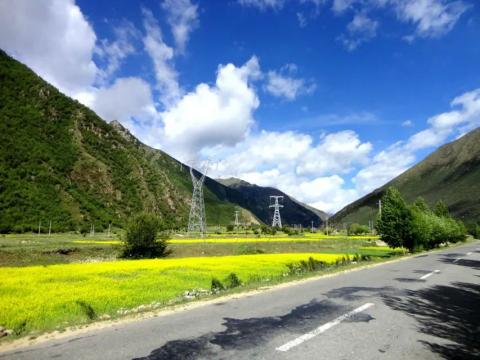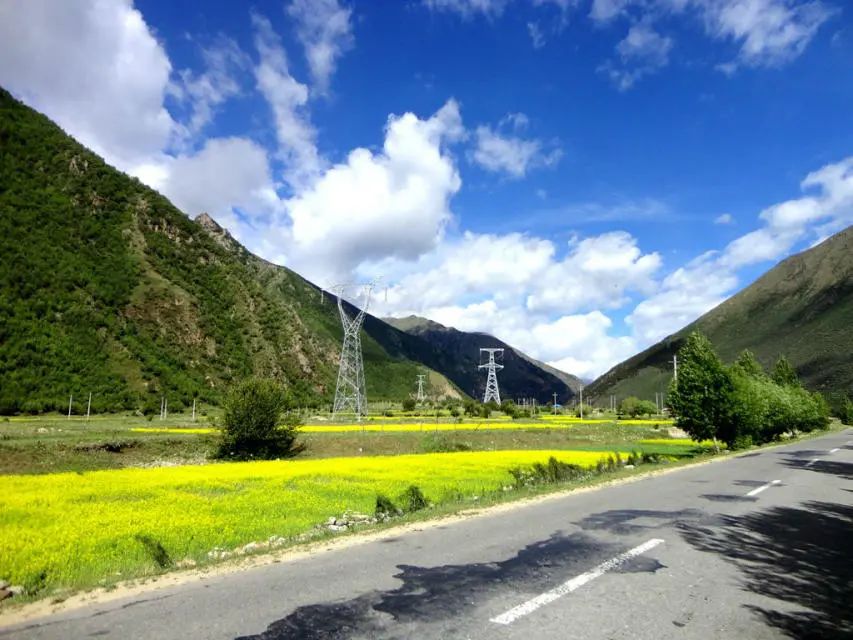
There are fewer people on Songduo Road and even fewer hotels than restaurants.
Although there are no high mountain passes from Gongbujiang to Songdo, the altitude rises 1,000 meters and the slopes are all gentle. The nearly 100 kilometers of the journey are all uphill, which is torture enough. I got up at 7 a.m. on the 13th, set off at 8.20 a.m., and arrived in Songdo after 5 p.m. For me, I was too tired and felt a little unbearable.

▲The scenery along the way is quite beautiful, especially the spring scene of cauliflower. I particularly love it, even if I am left behind in taking these photos.
Leaving Gongbujiangda and leaving the city, it is a gentle uphill climb. There is little buffer space. The strange thing is that his condition is very poor. Compared with yesterday morning, he is completely different. His physical and mental state are far worse than yesterday morning. After climbing 15 kilometers uphill, I had a stomachache and couldn't resist the convenience of the roadside. After that, I felt so empty that I couldn't even pedal. Despite this, I still had to ride up slowly step by step. Overall, I felt very tired, out of breath, and weak.

▲The journey of more than 100 miles from Gongbujiang to Songdo was not only unbearable for me, but also looking at my teammates, they were also exhausted.
At 12 noon, we finally arrived at Jinda Town. It was time to have lunch and take this opportunity to take a good rest. Fortunately, the cows and others had just arrived, so we randomly chose a Tibetan restaurant and ordered casserole noodles for 15 yuan a bowl. The three of us had more than three pieces of chicken in our bowls of noodles, and the noodle soup was particularly delicious - I lamented that Tibetans make it Business is real.

▲We were very satisfied with this bowl of casserole noodles!
Jinda Town is very small, just a short street. It seems that on market day, there are many people on the street, and most of them are Tibetans. In addition, most of the old Tibetan houses on both sides of the street make the entire market town look very original and reflect the true nature of the Tibetan people. Only in this kind of town can people appreciate the Tibetan customs to the maximum extent.

▲Jinda Town, with old Tibetan houses and bustling Tibetans going to market, highlights the unique ethnic atmosphere of this pure Tibetan town.
After lunch, I continued climbing, basically falling behind the cows and the others, and one person slowly held on behind. Fortunately, the cows and the others had almost walked a while and were waiting for me. I observed carefully along the way that there seemed to be a lot of cyclists who were as exhausted as me. Almost everyone before and after me was riding equally hard, and several groups of young people were still not riding fast and took too much time to rest. It seems that this is not just a matter of personal difficulty. Perhaps these more than 100 kilometers of uphill road really test people's endurance and will. Of course, it also illustrates a problem. Riding 318 is indeed not as simple as saying a word. You have to face various difficulties. , the first thing that bears the brunt is physical strength, followed by will and perseverance. If it doesn’t work, it doesn’t work, and you can’t avoid it. The difference is whether you grit your teeth and push through, or give in and just take a ride or a pushcart.

▲This large stone in the independent and fast river is called the "mainstay".
According to the guide, on the road to Songduo, you can see the "mainstay" and "four ancient scenic spots". To be honest, the "mainstay" is basically just a road sign and has no more sightseeing value - in the rushing river, A lone stone standing in the water, nothing more.

▲In this "Four Ancient Attractions", except for tour groups brought by tour guides, there are no more tourists.
As for the "Four Ancient Attractions", except for some tourists coming off the tour group bus, there were no more tourists. Besides, the few simple houses on the other side of the river are not famous at all, and the so-called Taizhao Ancient City, Tang-Tibo Ancient Road, Tea Horse Ancient Inn, Qing Dynasty ancient tombs, etc. are even more incomprehensible. So we just stayed there for a symbolic moment and left in a hurry. However, there were a few tourists who got off the tour group. They admired us cyclists and offered to take photos with us. First, we took photos with the hippos. , later heard that I was 58 years old, and was surprised and hurriedly came to take a photo with me again.

▲This is the so-called "Four Ancients" scenic spot, but we didn't see anything special about it.

▲It is this unique suspension bridge that interests the cows.
After leaving the "Four Ancient Attractions" and continuing to climb uphill, the last 20 kilometers of uphill road almost felt like collapse again. When I had no choice but to take frequent breaks, I often increased the number of breaks. In short, stick to one thing; no matter how tired or miserable you are, you will never hitchhike or push a cart! At most, either slow down or take more breaks. For this reason, I couldn't help but secretly rejoice: Fortunately, we are not far from Lhasa. No matter how hard and tiring it is, it will only be the last few days. If we have to ride for another ten or eight days, it is very likely that everything will collapse and be completely crushed.

▲I always suspect that these beautiful Tibetan houses are the actions of the government, not the Tibetans themselves.
Along the way, I noticed a common phenomenon - there are many rows of beautifully built Tibetan houses with exactly the same style on both sides of the road. Every house has one floor and one floor, and has its own small courtyard - I know it is A uniformly planned residential area, but what I can’t figure out is why every household looks the same? Is it true that every household’s economic strength and aesthetic taste are the same? Therefore, I doubt whether this is a government action, either a manifestation of blood transfusion, or a face-saving project. Of course, there is no basis for this, so we can only speculate privately.

▲Songduo Town, the streets are particularly spacious.
After five o'clock in the afternoon, we finally arrived at our destination - Songdo, and I let out a long sigh of relief!
Songduo Town is also a single street, but the planning is very generous. The entire street is estimated to be at least ten meters wide, but the houses on both sides are low, barely exceeding the second floor, which highlights the spaciousness of the street.

▲There are restaurants all over the street, one after another.
There are restaurants all over the street, one after another, also breaking the monopoly of Sichuan people, and there are also restaurants opened by Shaanxi people. The strange thing is that restaurants are out of proportion to hotels. There are only two hotels! Slightly equal to exclusive operation! After we arrived, we had no choice in finding accommodation. The Southern Hotel recommended by the guide was already fully booked, so we had to settle for the next best thing and stay at the "Qinchuan Inn" opened by Shaanxi people across the street.
I have never been particularly picky about accommodation, but what makes me extremely speechless about this "Qinchuan Inn" is that it doesn't have the most basic and basic hotel conditions - there is no bathroom in the entire hotel! If you want convenience, sorry, please go out to the open-air toilet - surrounded by several thin wooden boards less than 1.5 meters high, no roof, no distinction between men and women! ——Walking around the entire 318 Sichuan-Tibet Line, this is probably the only hotel like this!

▲The "Qinchuan Inn" we stayed in had no choice but to have no bathroom, which made me extremely speechless!
The guide said that the prices in Songdo are very expensive, but we still have to go to eat, and we can’t just eat instant noodles all the time. Went to a Sichuan restaurant. The two of them asked for boiled meat slices with the cow, and they were charged 50 yuan! Later, I communicated in Sichuan dialect, and the boss said that for the sake of fellow villagers, it was 40 yuan.
After dinner, the three of us discussed tomorrow's itinerary. According to the guide, we can go directly from Songdo to Lhasa, a journey of 176 kilometers. Although we have to climb more than 5,000 meters of Yela Mountain, the kilometers are too many, but this can satisfy the cyclists. Lhasa’s urgent desire. But we rejected the strategy plan and unanimously decided to only go to Mozhu Gongka! What matters to us is that destination is not the only thing! We have to maintain our strength and there is no need to fight hard. Instead of arriving exhausted, take your time and enjoy the process.
Exactly: After all the hard work riding in Sichuan and Tibet, why rush to Lhasa?
